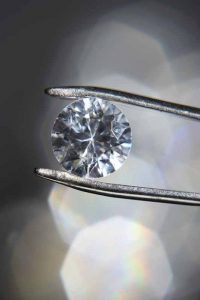Will history repeat itself?

The authors of The Global Diamond Industry draw a comparison between consumers’ acceptance of cultured pearls and rejection of synthetic rubies. Synthetic rubies were unsuccessful in disrupting the ruby market because they are generally of inferior quality and are easier and less costly to detect than other synthetics. However, this does not apply to the pearl and amethyst markets—cultured pearls are rounder and of higher quality than their natural counterparts. Also, the progressive decline of coral reefs has contributed to a decrease in the supply of natural pearls.
Amethyst provides another example of how the creation of synthetics has caused prices to decrease. When an electrical current is applied to an amethyst, the atoms vibrate at a consistent frequency, making the gem well-suited to keeping track of time and an ideal component in watches. After the Second World War, there was a high demand for and very low supply of natural quartz (i.e. amethyst), leading to the development of synthetic quartz in 1955. (More information is available here.) The prices of amethysts fell, as synthetic amethyst was of better quality and was easier and cheaper to produce.
Similarly, synthetic diamonds’ quality can be higher than that of their natural counterparts in terms of the four Cs. It has also become impossible for gemmologists to identify a synthetic diamond with a microscope or the naked eye. When considering the evolution of synthetics across other gemstone markets, diamonds follow the same pattern as cultured pearls and synthetic amethysts: there has been increased demand and low supply, the gemstones are of higher quality, and there is difficulty and cost associated with distinguishing synthetics from natural gems.
Selling to a modern market
Today, there isn’t a single market that has not been disrupted by technology. In evaluating the future growth potential of any industry, it is worth examining how the current players, big and small, are behaving. One of the biggest trends is the growth of online sales, which currently accounts for four to five per cent of sales and is expected to capture 15 per cent of the market by 2020. (For more information, click here.) Many online and established jewellery retailers, such as Spence and Stuller, are already selling synthetic diamonds as environmentally friendly and sustainably sourced.
Although global jewellery sales are expected to increase over the years, it is unclear if this is reflected in the North American market, looking specifically at the behaviour of millennials. Individuals in this age bracket are struggling with paying off student loans, opting for service-sharing platforms (e.g. car sharing), putting off weddings, and living with their parents in order to save to purchase houses. Further, millennials place a higher value on experiences as opposed to owning things. (More about millennial spending can be found here.)
Bain’s Worldwide Luxury Report states, “In addition to the shift toward purchasing luxury experiences, a few other luxury trends were particularly noticeable this year: increased casualization, the rise of discount and online, and a revitalization of local consumption.”

In other words, millennials are not spending as much money on luxury jewellery as previous generations. For instance, if a couple is buying an engagement ring, they are likely to spend less on the ring so they can put more money toward their honeymoon.
As a millennial, I can certainly empathize with this situation. Keeping in mind Moore’s Law—which states processing power of technology is increasing while its cost decreases—it is only a matter of time until the industry consistently develops perfect diamonds at a lower price. Consumers may ask themselves, “Would I rather spend less money on an IF, D colour synthetic diamond, or more money on a natural, VS1, F colour?”
Millennials have also shown a tendency to want to be different. Perhaps in the future, there will be a greater focus on customization of jewellery designs as opposed to varying diamond qualities.






Giselle: This article is one of the best and most comprehensive I’ve read. Since you don’t mention the Chinese … I see the Chinese producers being able to match De Beers Light Box pricing as they are now pressured to lower costs and this will be by lowering the high cost of human [growth] monitoring with automation (labor is highest cost). Why is this important? Taken as a whole Chinese producers have the stamina to be the largest producing block. They, like De Beers E6, are focusing not only gem synthetic diamond but also industrial applications. Why has De Beers chosen Oregon for a production site? It lies within the rich US west coast tech centers from San Francisco to Seattle where hardware and talent are being sourced for their production facility plus close proximity to future tech synthetic diamond business. The revenue from tech sales will fortify producers against any ups and downs and price pressure in the gem market. Light Box is a brilliant strategy and combined with E6 tech sales and other western producers there is competition against the Chinese … at least for the near future. The big Panda may just take the largest slice of synthetic diamond production. China’s ramp up in tech will be an irritating rash on the west! Tariffs anyone?
Hi Mark,
Thank you for your comments. As for DeBeers’ strategy, I couldn’t agree with you more. Also, I didn’t know the reason behind them choosing Oregon as their production site. I would love to discuss the subject further with you if you wish. My e-mail is gisellesaati@gmail.com.
Thank you again for your insights!